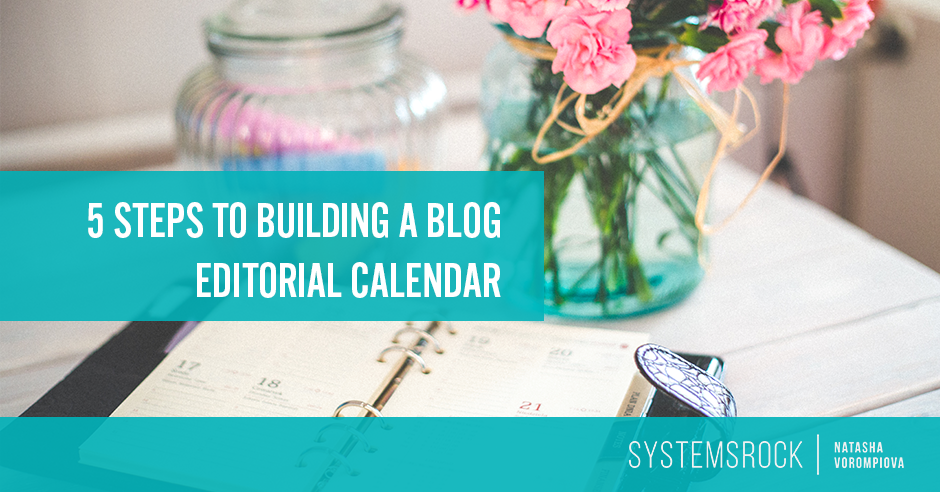by Lacy Boggs
Can I ask you a personal question?
Why do you blog for your business?
Don’t worry; if you don’t really know — you’re not alone.
Most online business owners understand that they need a blog for their business, but many don’t really know why.
In my humble opinion as a professional blogger and content director, if you are a business owner with a blog, your blog should be supporting your business, simple as that.
I mean, if you’re spending time writing a blog, shouldn’t it be doing something meaningful to support your business goals — like earning you leads or making you more sales?
But blogging like that requires a plan, a system, and a strategy.
What is an editorial calendar?
Every newspaper, magazine—and yes, major blog—that you read has an editorial calendar. It can be simple or very complex, but it’s basically just a tool to help you plan and keep track of your content.
Even major blogs use an editorial calendar to plan content a few weeks to possibly a few months in advance—especially when they want to use the blog to promote a new product or service they’re launching.
If you want to use your blog to help turn your readers into raving fans and customers, you’ve got to have a plan for how you’re going to achieve that — and a system to keep it all organized.
I’ve devised an editorial calendar system that I’m happy to share. Just click here to access it. Here’s how the system works:
Use the 5 Ws to build your editorial calendar
What you can steal from journalists here are the 5 Ws—who, what, when,where, and why. That’s like Journalism 101 for covering a story. (In fact, you probably learned that writing reports back in grade school.)
But it’s also Blog Editorial Calendar 101. You have to be able to answer the five Ws for your blog and all the posts you plan to write if you want your blog to be an effective marketing and selling tool for your business.
When I build an editorial calendar, I answer each of these questions for every post I plan to write:
- Who are you writing for?
Who is your ideal reader? (Here’s a hint: your ideal reader is the one who converts into a customer!) If you only have one ideal reader profile, write as though you were speaking directly to him/her; but if you have more than one, be sure you know which reader each post will appeal to. - What are you going to write about?
This is where you answer that age-old question that plagues writers everywhere. But when you’ve got a bigger overall plan, it shouldn’t be too hard to answer. What do you need to support in your business right now? Do you need to write a post to attract attention and gain more followers? Set up desire for one of your offerings? Start there and the topics will flow. - When are you going to write each post?
In the most basic sense, this is the calendar part of the editorial calendar. But it also refers to that bigger plan that takes into account your sales cycles, your product launches, discounts and coupons, guest blogs, and the like. Start with the stuff that’s already written in your calendar (a product launch, for example, or a holiday your customers will be celebrating) and work backwards. - Where are you going to promote it?
Writing the blog post is only 20 percent of the work, and promoting it is the other 80 percent. If you’re not thinking about where you’re going to promote your work, you’re wasting a lot of your effort. - Why are you writing this post?
You shouldn’t write anything unless you can answer the question WHY, because the answer tells you where each post fits into your overall blog strategy. Are you trying to add people to your list? Make more sales? Become a thought leader in your industry? The reason will change how you approach the subject.
In my system, each of these questions corresponds to a column in a spreadsheet. That way I can easily see my big picture strategy: I know what I’m writing about when, and to what end. But you can easily adapt this to the tools you use most in your business, like Evernote or Asana.
But what about spontaneity?
The editorial calendar is just a tool. You’re still the boss. If inspiration strikes and something new comes up that you want to write about it, go for it! Your editorial calendar is a living document, that changes as your business needs do.
When the inspiration is flowing, flow with it. When it’s not, your calendar is your backup plan.
Don’t write another post without a plan.
Got questions about this? I’d love to answer them in the comments!
BIO
 What does it take to have an immensely popular blog that actually drives sales for your business? It’s all about strategy. Lacy Boggs is an innovative wordsmith who teaches business owners how to zoom out and look at the blog big picture first by helping them develop streamlined strategies and writing rituals that make blogging efficient and effective and put their content to WORK converting readers to clients. Check out her free library of resources for bloggers at http://lacyboggs.com/library.
What does it take to have an immensely popular blog that actually drives sales for your business? It’s all about strategy. Lacy Boggs is an innovative wordsmith who teaches business owners how to zoom out and look at the blog big picture first by helping them develop streamlined strategies and writing rituals that make blogging efficient and effective and put their content to WORK converting readers to clients. Check out her free library of resources for bloggers at http://lacyboggs.com/library.


